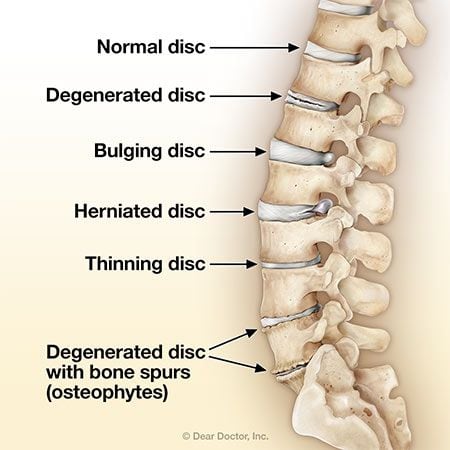Osteoarthritis of the spine, or spondylosis, is something that happens to many people as they age. This diagnosis refers to degenerative changes in the spine, which may include bone spurs or degenerating discs. For some people, discs can begin the degeneration process as early as our teen years, and, as a result, can become bulging or herniated. The onset of osteoarthritis most commonly occurs in adults between the ages of 20–50. Over 80 percent of adults over the age of 40 have evidence of arthritis visible on x-rays.
Age of Onset and Symptoms of Osteoarthritis of the Spine

The age of onset of osteoarthritis symptoms is impacted by lifestyle and genetic factors. Spinal injuries, for example, can increase a person's risk of arthritis and cause symptoms to appear at an earlier age. Osteoarthritis is more likely to develop in spinal joints that have sustained a previous injury and can take years to develop. Other risk factors include having an occupation that requires repetitive neck movements, overhead movements with awkward positioning, genetic factors, a sedentary lifestyle and smoking. This condition may occur in any of the sections of the spine but is most common in the cervical (neck) and lumbar (lower back) sections. Osteoarthritis can impact one single vertebra, or it can be multilevel—that is, impacting multiple vertebrae at once.
Symptoms of osteoarthritis of the spine may not be noticed by a large percentage of those who have it. 27–37 percent of those with osteoarthritis of the lower back do not have any symptoms. Those who do experience symptoms tend to report neck, shoulder or back pain and may also have headaches, tenderness, muscle spasms and trigger points. More advanced stages may also be accompanied by tingling, numbness and weakness in the limbs or difficulties with walking. These symptoms are typically caused by a pinched nerve, increased inflammation, a bulging or herniated disc, or bone spurs on the facet joints (joints of the spine). Such conditions can also cause inflammation and spinal nerve sensitivity, and the pain can range from mild and sporadic to chronic and aggressive.
In certain cases, additional conditions may develop along the spine, depending on the nature of the arthritis. A condition called radiculopathy can occur when a spinal disc herniation pinches the nerve roots as they emerge from the spinal cord. Sciatica may occur if the sciatic nerve connecting the lower back to the back of the leg and foot is compacted. In other cases, the spinal cord itself can be compressed due to trauma, stenosis (narrowing of the spinal canal), degenerative disease or disc herniation; this condition is referred to as myelopathy.
Diagnosing and Treating Osteoarthritis of the Spine
If you are concerned that you may have osteoarthritis, a chiropractor can diagnose your condition. Upon visiting a chiropractor, a series of tests may be run to determine if there is any degeneration in the spinal vertebrae and discs. Imaging tests may be recommended. If osteoarthritis of the spine is detected, chiropractic treatments may include low-level laser treatments, ice and heat therapy, ultrasound therapy and massage. Regular spinal adjustments will also most likely be performed to help correct and alleviate pain from bulging or herniated discs, pinched nerves or restrictions along the spine. Lifestyle modifications may also be recommended to support greater overall health.
Why Seek Chiropractic Care for Osteoarthritis of the Spine?
Osteoarthritis can result from wear and tear on the spine, but we don't have to live with many of its unpleasant symptoms. Various research studies have shown the positive effects of chiropractic care for treating symptoms of osteoarthritis. Chiropractors can help correct misalignments of the spine caused by bulging or herniated discs and bone spurs while reducing pain and other symptoms.
While osteoarthritis of the spine can't be reversed, chiropractic maintenance care can slow down its progression. Taking good care of your spine by seeing your chiropractor regularly and avoiding a sedentary lifestyle can help reduce or even prevent arthritis of the spine. We can help keep your spine healthier longer and support you in living a pain-free, healthy and active lifestyle.


